| Emu Bay Railway 11 class | |||||||||||||||||||||||
|---|---|---|---|---|---|---|---|---|---|---|---|---|---|---|---|---|---|---|---|---|---|---|---|
 1107 on the Bellarine Railway. | |||||||||||||||||||||||
| |||||||||||||||||||||||
| |||||||||||||||||||||||
| |||||||||||||||||||||||
| |||||||||||||||||||||||
The Emu Bay Railway 11 class were a class of diesel-hydraulic locomotives built by Walkers Limited, Maryborough for the Emu Bay Railway between 1969 and 1971.
| Emu Bay Railway 11 class | |||||||||||||||||||||||
|---|---|---|---|---|---|---|---|---|---|---|---|---|---|---|---|---|---|---|---|---|---|---|---|
 1107 on the Bellarine Railway. | |||||||||||||||||||||||
| |||||||||||||||||||||||
| |||||||||||||||||||||||
| |||||||||||||||||||||||
| |||||||||||||||||||||||
The Emu Bay Railway 11 class were a class of diesel-hydraulic locomotives built by Walkers Limited, Maryborough for the Emu Bay Railway between 1969 and 1971.
In 1968, with EZ Industries and the Mount Lyell Mining & Railway Company to establish a sulphuric acid plant in Burnie, the Emu Bay Railway ordered five diesel-hydraulic locomotives from Walkers Limited to the same design as the Queensland Railways DH class. [1] [2] All were delivered in December 1969. [3] [4] A further two were delivered in March 1971. [5] [6]
All were included in the April 1998 sale of the Emu Bay Railway to the Australian Transport Network. [7] Following the cessation of vacuum braked trains in March 2002, they were withdrawn and sold to Queensland operators. [8] By 2019, six were owned by Cairns Kuranda Rail Services and one by Downer Rail. [9]
| Number | Builder's number | Owner |
|---|---|---|
| 1101 | 638/1969 | Cairns Kuranda Rail Services |
| 1102 | 639/1969 | Cairns Kuranda Rail Services |
| 1103 | 640/1969 | Cairns Kuranda Rail Services |
| 1104 | 641/1969 | Downer Rail, Maryborough, Queensland |
| 1105 | 642/1969 | Cairns Kuranda Rail Services |
| 1106 | 643/1970 | Cairns Kuranda Rail Services |
| 1107 | 644/1971 | Cairns Kuranda Rail Services |

Japan Freight Railway Company, or JR Freight, is one of the seven constituent companies of Japan Railways Group. It provides transportation of cargo nationwide throughout Japan. Its headquarters are in Shibuya, Tokyo near Shinjuku Station.

The British Rail Class 17 was a class of 117 Bo-Bo diesel-electric locomotives built 1962–1965 by Clayton Equipment Company and their sub-contractor Beyer, Peacock & Co., on behalf of British Railways (BR).

The British Rail Class 42 Warship diesel-hydraulic locomotives were introduced in 1958. It was apparent at that time that the largest centre of expertise on diesel-hydraulic locomotives was in West Germany. The Western Region of British Railways negotiated a licence with German manufacturers to scale down the German Federal Railway's "V200" design to suit the smaller loading gauge of the British network, and to allow British manufacturers to construct the new locomotives. The resultant design bears a close resemblance, both cosmetically and in the engineering employed, to the original V200 design. Warship locomotives were divided into two batches: those built at BR's Swindon works were numbered in the series D800-D832 and D866-D870, had a maximum tractive effort of 52,400 pounds-force (233,000 N) and eventually became British Rail Class 42. 33 others, D833–D865, were constructed by the North British Locomotive Company and became British Rail Class 43. They were allocated to Bristol Bath Road, Plymouth Laira, Newton Abbot and Old Oak Common.
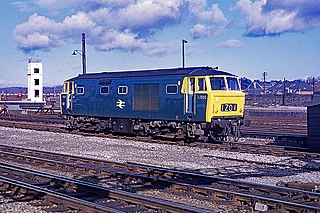
The British Rail Class 35 is a class of mixed-traffic B-B diesel locomotive with hydraulic transmission. Because of their Mekydro-design hydraulic transmission units, the locomotives became known as the Hymeks. They were numbered D7000-D7100.

The Australian Standard Garratt (ASG) was a Garratt articulated steam locomotive designed and built in Australia during World War II for use on the 1067 mm narrow-gauge railway systems owned by the Australian states of Queensland, South Australia, Tasmania and Western Australia. After the war, ASGs operated in South Australia and at the Fyansford Cement Works railway in Victoria.
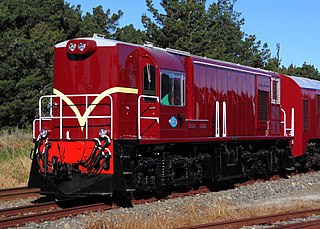
The New Zealand DI class locomotive was a class of diesel-electric locomotive in New Zealand. They were built by English Electric at their plant in Rocklea, Queensland in Australia. The class is very similar to the Queensland Railways 1620 class locomotives. At the time of their introduction, the class was seen as an alternative to the DB class for use on lightly laid secondary and branch lines, more so in the South Island. The World Bank financed introduction of the Japanese built DJ class in 1968, which ensured that no further DI class locomotives were purchased by New Zealand Railways.

The Tasmanian Government Railways (TGR) was the former operator of the mainline railways in Tasmania, Australia. Formed in 1872, the railway company was managed by the Government of Tasmania, and existed until absorption into the Australian National Railways Commission in 1978.

The Tasmanian Government Railways Y class is a class of diesel locomotives built by the Tasmanian Government Railways between 1961 and 1971.
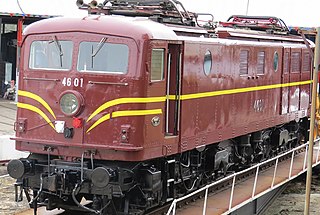
The New South Wales 46 class was a class of mainline electric locomotive built by Metropolitan-Vickers and its partner Beyer, Peacock & Company in England for the Department of Railways New South Wales. They later operated for the Public Transport Commission, State Rail Authority and FreightCorp with most remaining in service into the 1990s.

Walkers Limited was an Australian engineering and shipbuilding company based in Maryborough, Queensland. It built large vessels and railway locomotives. The Walkers factory still produces locomotives and rolling stock as part of Downer Rail.

The 73 class is a diesel-hydraulic locomotive built by Walkers Limited, Maryborough for the New South Wales Department of Railways between 1970 and 1973.
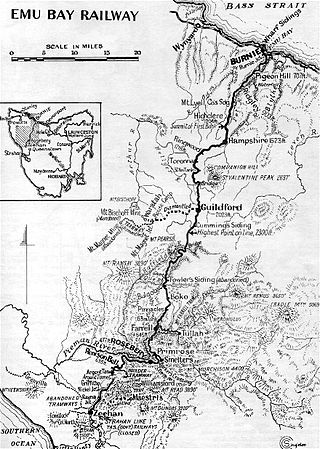
The Emu Bay Railway was a Tasmania, Australian railway company. The railway was significant during full operation, in that it linked the Tasmanian Government Railways system at Burnie with that at Zeehan that further linked to the Mount Lyell railway allowing connection through to Queenstown.

The Bellarine Railway, formerly the Bellarine Peninsula Railway, is a volunteer-operated steam-driven tourist railway located in Victoria, Australia. It operates on a 16 km section of a formerly disused branch line on the Bellarine Peninsula between the coastal town of Queenscliff and Drysdale, near Geelong.
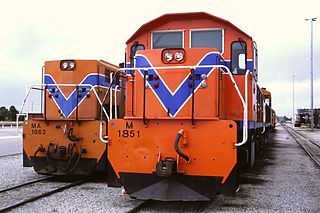
The M/MA class are a class of diesel-hydraulic locomotives built by Walkers Limited, Maryborough for the Western Australian Government Railways in 1972–1973.

AN Tasrail was an Australian railway operator that operated the Tasmanian rail network from March 1978 until November 2004. Originally a subsidiary of the Federal Government's Australian National, it was sold to Australian Transport Network (ATN) in November 1997. ATN was acquired by Pacific National in 2004 and the AN Tasrail subsidiary was later acquired by the Tasmanian Government in 2009 to become TasRail.
The Tasmanian Government Railway Z class are a class of diesel locomotives built by English Electric, Rocklea for the Tasmanian Government Railways in 1973. They were a development of the Western Australian Government Railways R class and were the last of a line of very successful locomotives fitted with the English Electric 12CSVT Mk II engine.

The Tasmanian Government Railways V class are a class of diesel locomotives operated by the Tasmanian Government Railways.

The Emu Bay Railway 10 class are a class of diesel-hydraulic locomotives built by Walkers Limited, Maryborough for the Emu Bay Railway between 1963 and 1966.
The West Coaster was a passenger train operated by the Emu Bay Railway between Burnie and Rosebery from October 1960 until January 1964.
![]() Media related to Emu Bay Railway 11 class at Wikimedia Commons
Media related to Emu Bay Railway 11 class at Wikimedia Commons